| Location | CEW | TBW |
| Hardeman (Bolivar) | 5 | 0 |
| Fayette (Whiteville) | 45 | 0 |
| Fayette (Somerville) | 2 | 0 |
| Shelby (Millington) | 22 | 0 |
| Tipton (Covington) | 3 | 0 |
| Tipton (North) | 26 | 0 |
| Lauderdale (Golddust) | 20 | 0 |
| Haywood(West) | 32 | 1 |
| Haywood (Brownsville) | 19 | 3 |
| Madison (WTREC) | 13 | 0 |
| Madison (North) | 0 | 0 |
| Crockett (Alamo) | 0 | 2 |
| Crockett (Friendship) | 14 | 0 |
| Dyer (King Rd) | 5 | 1 |
| Dyer (Dyersburg) | 34 | 1 |
| Lake (Ridgely) | 21 | 4 |
| Gibson (Trenton) | 26 | 0 |
| Gibson (Milan Rec) | 1 | 0 |
| Carroll (Coleman Farm) | 1 | 0 |
Category Archives: Insects
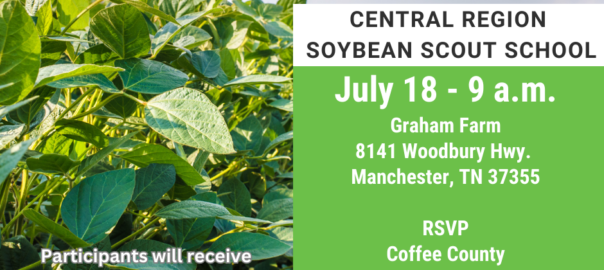
UT Soybean Scout Schools
UT’s Soybean Scout Schools will be held in July (see details below). These field-side programs cover the basics of soybean growth, scouting, pest identification, and general management. Three Pesticide recertification and CCA CEU points will be available. Scout Schools are offered free of charge with sponsorship from the Tennessee Soybean Promotion Board. Registration is not required. Participants will receive a scouting notebook and a sweep net while supplies last.
West TN – Madison County, July 17th, 9:00 AM – 11:30 AM. This school will be at the West TN Research and Education Center, 605 Airways Blvd. Jackson TN, 38301. Signs will be up at the station to direct you to the field.

Middle TN – Coffee County, July 18th, 9:00 AM – 11:30 AM. This school will be at Graham Farms,8141 Woodbury Hwy., Manchester, TN. Please contact Amy Willis Prince of the UT Coffee County Extension Office at 931-723-5141 or awillis2@utk.edu if you plan to attend.

East TN – Monroe County, July 19th, 9:00 AM – 11:30 AM. This school will be held at the Monroe County Farm Bureau Office 501 Main Street, Madisonville, TN 37354. Lunch will be provided. A head count is required for the meal, please contact Jonathan Rhea of the UT Monroe County Extension Office at 423-442-2433 or jrhea@utk.edu if you plan to attend.
Spider Mite Numbers Increasing in Cotton
I’ve received several phone calls about spider mites increasing in cotton around West Tennessee. Spider mites favor hot, dry weather and will often become an issue after plant bug applications are initiated. UT recommends treatment when 30-50% of plants are showing signs of injury and spider mites are still present. Treatment options are fairly limited and most are mite specific. Abamectin based products are typically the first option because they are economical and effective. There are a couple different formulations of abamectin that are different lb/ai per gallon products. Below is a rate conversion of 0.15 lb ai/gallon formulations (Willowood Abamectin 0.15 EC, etc) to 0.7 lb ai/gallon formulations (Agri-mek SC 0.7, Willowood 0.7 SC, etc).
5.0 fl oz/a = 1.0 fl oz/a
7.0 fl oz/a = 1.5 fl oz/a
8.0 fl oz/a =1.75 fl oz/a
10.0 fl oz/a = 2.0 fl oz/a
Abamectin rates below 7.0 fl oz/a or 1.5 fl oz/a should be avoided due to potential resistance issues and the increased likely hood of retreatment.
Other mite products such as etoxazole (Zeal, Stifle) are mite growth regulators that work very well but are more expensive and somewhat slower than traditional miticides. Fenpyroximate (Portal) is a contact miticide that has a shorter residual than abamectin or etoxazole but works very well. Bifenthrin alone is not an adequate miticide and should be avoided.
Products used for controlling plant bugs, bollworms and stink bugs (OPs, pyrethroids) exacerbate mite populations and their use, especially during hot dry conditions, should be delayed until after bloom if possible. Mite populations can rebound quickly after miticide applications so diligent scouting is critical to slowing the spread of mites across a field.
One final note, I’ve received a few questions/observations of spider mites appearing to be worse in ThryvOn vs non-ThryvOn cotton. Based on what we know about the repellency or reduction of colonization of Western flower thrips and Tobacco thrips in ThryvOn varieties, it is very plausible that spider mites could appear sooner and be more severe in ThryvOn cotton. Adult and immature thrips are spider mite predators and can help keep mite infestations in check under optimum conditions. ThryvOn’s Bt trait reduces thrips numbers season long and may increase the likelihood of spider mite flare ups as the summer progresses. Keep a close eye on your cotton, especially ThryvOn for mites.
Tarnished Plant Bug Migration into Cotton
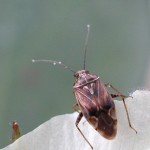
I’ve received several calls on adult tarnished plant bug migration into ThryvOn cotton. Silking corn, blooming soybeans and flowering pigweed all contribute to large increases in plant bug numbers that make their way to cotton. ThryvOn’s bt gene can help reduce the amount of injury plant bugs inflict to squaring cotton but adults, especially large numbers of adults, can knock squares off of ThryvOn just like non-ThryvOn. I’ve seen ThryvOn cotton go from 90 plus percent square retention to sub 50 percent in 5 days due a large, consistent migration of adult plant bugs. The biggest benefit we see from ThryvOn is the reduction of plant bug immatures in bloom. That being said, you will typically see increased square retention in ThryvOn vs non-ThryvOn throughout the fruiting period. Scout your cotton and don’t ignore migrating plant bugs in ThryvOn or non-ThryvOn.
Insecticide performance thus far is pretty standard for pre-bloom cotton. 2.0 oz/a of Centric is performing well on plant bug populations 2 to 3x above threshold on the station and in the field. Although the same class of chemistry, imidacloprid’s performance is fair at best and recolonization often happens quickly after an imidacloprid application. I try to not recommend consecutive applications of neonics due to efficacy falling off after the first shot. However, consecutive shots of neonics may be warranted for several reasons (cost, presence of mites, personal choice etc.) and on the second application I tend to increase rates of Centric to 2.5 oz/a especially if it was used previously. After the second application we’ve pretty much exhausted that chemistry. Other options are acephate, which carries a high risk of flaring mites and aphids especially in our current dry period, Vydate which is effective in killing plant bugs but has limited residual, roughly 36 hours. Bidrin isn’t labelled for plant bugs between first square and bloom. Transform, which is very effective, but is expensive and many want to save those shots for bloom unless aphids are present and Diamond. Diamond’s activity is best utilized in the 3rd week of squaring to first bloom window, several studies at MSU and UT have shown the best ROI of 6.0 fl oz/a Diamond during that time period.
Final note, I’ve received a few questions on squaring cotton having poor square retention but very few or no plant bugs are found scouting. Adult plant bugs, especially at this time of year, will move in and out of cotton quickly. The abundance of alternative hosts facilitates movement in and out of cotton without colonization. The take home is since most are scouting once a week, it is prudent to be more aggressive with applications and not risk square retention falling below 80% if you’re close. Monitoring square retention is one of, if not, the best way to determine if early-season treatments are working. Migrating adults can give the impression of an insecticide failure, but maintaining good square retention is an good indication that treatments are working.
Thrips Considerations in Cotton
With warm conditions moving into West TN, many producers are well underway with cotton planting. Below are a few things to consider with regards to thrips control.
ThryvOn: ThryvOn is Bayer’s new Bt technology that has activity on thrips and plant bugs. ThryvOn cotton varieties are very effective against thrips and it is not anticipated that any fields will need foliar treatments. ThryvOn will still have thrips present (adults and immatures) but insecticide applications should not be triggered on thrips numbers but damage level (Fig 1.). Applications should be initiated when plant damage is approaching 3 in figure 1. That being said, I’ve evaluated ThryvOn varieties for several years under excellent and terrible growing conditions and I as well as my colleagues across the cotton belt, have never recommended a foliar spray for thrips.
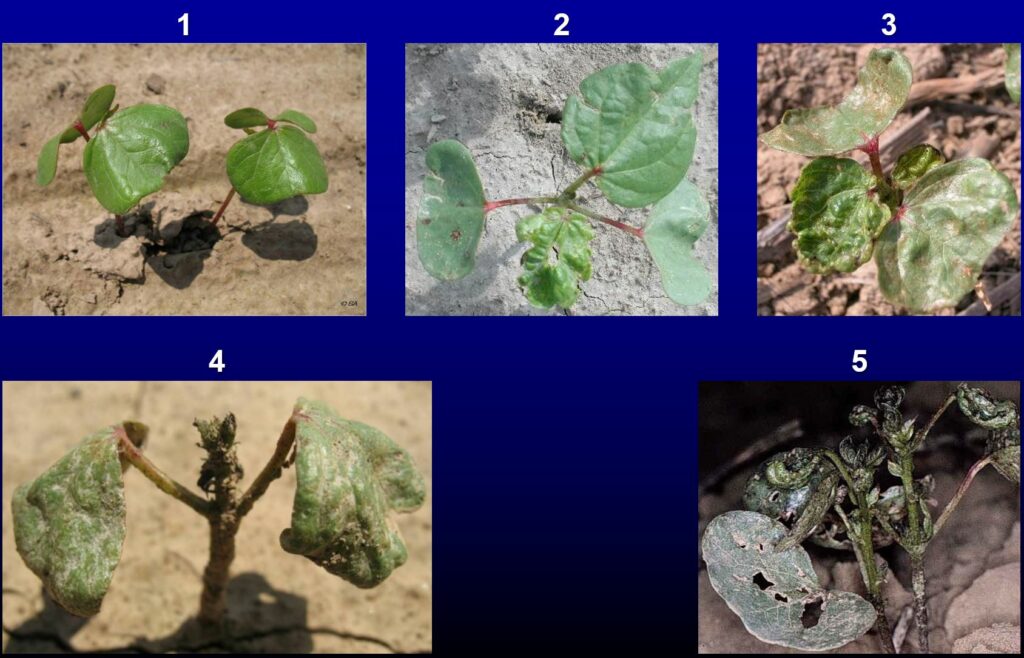
Insecticide Seed Treatments (ISTs): ISTs are the predominate control method for thrips in cotton. IST performance can be highly variable depending on weather conditions and thrips pressure. High thrips pressure and poor growing conditions will often necessitate the use of foliar sprays even with ISTs. Seed treatment packages typically come in a base (storage rate of imidacloprid + fungicide) and field rates of imidacloprid (these have several names) + fungicides, others may have nematicides, biologicals etc. Base treated seed may as well have no insecticide, the small stored product rate will offer almost no control of insects in the field. Standard options of imidacloprid (0.375 mg ai/seed) are the minimum needed for insect control in field cotton.
In-furrow: In-furrow liquid applications of imidacloprid are more effective than seed treatments; however, resistance development to neonicotinoids are diminishing the efficacy of imidacloprid in-furrow. Fields with in-furrow imidacloprid may still require a foliar spray under heavy thrips pressure. Granular AgLogic (aldicarb 15G) is highly effective against thrips populations and works like aldicarb should.
Foliar Spray Options: My recommendations are going to be limited for foliar sprays. Based on ongoing tobacco thrips resistance monitoring, to organophosphates (OPs), started by Scott Stewart several years ago, I am hesitant to recommend Orthene or Bidrin for thrips sprays. Resistance levels, in assayed populations from West TN, and the number of complaint calls I received last year are a good indication that OPs have limited use against our tobacco thrips populations. There may be areas where OP’s worked last year but it’s hard to say if they will work this year. That being said, Intrepid Edge at 3.0 fl oz/a is my go to for foliar thrips control. Although more expensive than the OPs, Intrepid Edge runs no risk of flaring mites or aphids and a surfactant has shown to increase efficacy (herbicide surfactants will work if you’re co-applying). Recolonization vs failure is another subject with foliar sprays. Presence of adults doesn’t mean the application didn’t work, adult thrips are always present on seedling cotton. Presence of immature thrips means adults are feeding and laying eggs and whatever control method you used is broken.
I am big believer in NCSU’s thrips predictor model https://products.climate.ncsu.edu/ag/cottontip/. We utilize the model to target planting when thrips numbers are highest, growers would do the opposite. Model runs for locations around West TN show that cotton planted May 1st through the 15th have a low to very low probability of experiencing large thrips populations. This is hopefully a welcome relief from years of cold, wet springs with large thrips populations plaguing our cotton. The warm, dryish weather will help germinate cotton quicker and standard ISTs may be enough to push us to the 4 true leaf stage (when thrips are typically no longer a concern) without a foliar spray.
Breaking the Green Bridge
As general rule, no-till production increases the risks from pests including slugs, cutworm, threecornered alfalfa hopper and several below ground pests such as wireworm and southern corn rootworm. Tillage is not an option in most of Tennessee’s agricultural landscape. This leads entomologists to recommend spring “burndown” applications 4 weeks in advance of planting. The goal is to “break the green bridge” or eliminate alternative hosts (weeds, cover crops) well before planting the cash crop.
However, making burndown applications 4 weeks prior to planting isn’t always possible or it doesn’t align with the goals of having cover crops. One way to help mitigate potential insect issues in late burndown is to add a pyrethroid insecticide with your herbicide application or within 7 days of planting. Beware blooming and pollinator attractive cover crops (vetch, brassica species) may have foraging honey bees and pyrethroids should not be utilized until the plants are not longer attractive to pollinators (desiccated or senescing from herbicides).
Utilizing insecticide seed treatments will offer protection against pest insects that may feed on your cash crop. If you are planting green (not burning down cover crops until after planting) I highly recommend a robust insecticide seed treatment and a pyrethroid insecticide that is included with the burndown herbicide. In corn this would be Poncho 500 or 1250, in soybeans Gaucho or Cruiser treated seed and in cotton Gaucho or Aeris based treatments will offer adequate protection from most below ground and some above ground pests. Keep in mind, seed treatment residual activity is strongly influenced by environmental factors, plant growth and amount of AI on the seed.
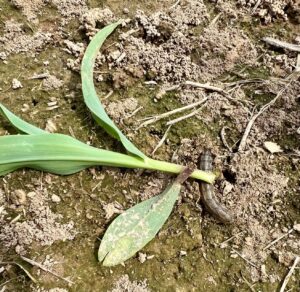
Cutworms in corn and cotton are uncommon but can be a serious pest. Pyrethroid applications within a week of planting will significantly reduce the risks of cutworm issues at low cost. Insecticide seed treatments are normally not enough to control cutworms and Bt traits in corn and cotton can offer mixed results depending on the traits. Three gene corn and cotton (those that include the Vip trait) provide better cutworm control than dual gene corn and cotton (V2TP, BG2 etc).
Overall, I like to see farmers planting in grave yard dead fields of weeds or cover crops but that isn’t always the case. Providing protection for your cash crop, at a relatively low expense, may help avoid the painful and costly decision to replant.
Soybean Looper Numbers Increasing
I’ve received several calls about looper numbers increasing in soybeans across West Tennessee. Numbers range from 3 per 25 sweeps to 25 per 25 sweeps. Treatment is recommended when defoliation exceeds 20% from R1 to R6 or if looper numbers exceed 19 per 25 sweeps. It’s often suggested to ignore small worms (<1/2 inch) in these counts due to predators and entomopathogens taking a substantial toll on their survival.
Pyrethroid additions, at R3 fungicide timing, can exacerbate looper numbers and shouldn’t be included unless they are needed. This is one of the reasons I caution against including an automatic pyrethroid with fungicides at R3 and those applications won’t have any measurable impact on stink bug numbers when the beans hit R5. Loopers are one of the top pests encountered in late planted soybeans and are the most expensive to control. Further, I received word from my colleagues in Mississippi that low rates of diamides (1.2 fl oz/a Vantacor, 7.0 fl oz/a Besiege, 14.0 fl oz/a Prevathon) are providing unacceptable levels of control in large populations of loopers. This isn’t a surprise but take caution when utilizing diamides. Reports of diamide slippage on loopers has occurred for several years and more often than not, it occurs when low rates are utilized against high numbers (>1.5X threshold). Another product, Intrepid 2F (methoxyfenozide), has also had some control issues in Arkansas and Mississippi. Rates of 4.0 and 6.0 fl oz/a did not provide satisfactory control of loopers 7 days after application; however, Intrepid Edge (methoxyfenozide + spinetoram) performed very well. We have several insecticide options available at our disposal but if you’re facing large numbers, low rates of any product (especially the diamides) probably won’t cut it.
One final comment, don’t confuse soybean loopers with green cloverworms. Loopers have 2 pairs of prolegs cloverworms have 3 (see images below). Cloverworms are much easier to control than loopers and pyrethroids, as well as other insecticides, work well. Information on insecticide options for loopers can be found here: https://guide.utcrops.com/soybean/soybean-insect-guide/soybean-looper/
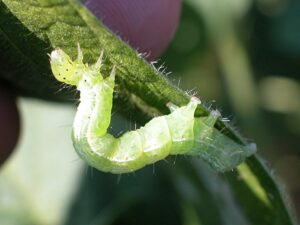
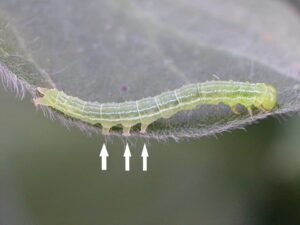
Fall Armyworm Update
I’ve been asked several times over the past week if armyworms are beginning to appear in Tennessee. There are a FEW isolated cases of fall armyworms infesting crops planted for wildlife, mainly millet. The instance and number of worms being found thus far is normal. Tennessee will still have armyworms that migrate North and infest pastures, food plots and the occasional yard. However, the wormageddon that happened in 2021 was a very unique event and will not occur yearly.
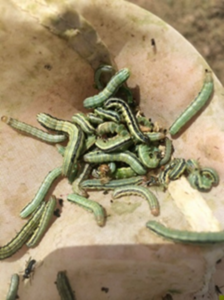
Fall armyworms don’t overwinter in Tennessee and populations migrate North from Texas and Florida every year. The difference in 2021 vs 2022 is the conditions that were occurring in April and May in South Texas. Texas experienced a warm and unseasonably wet spring that allowed for the proliferation of extremely large numbers of armyworms. Large numbers of moths plus ample food supply in pasture grasses, fallow grasses, yards and pretty much anywhere that had grass allowed this “army” to make its way North. Texas experienced outbreaks first followed by Louisiana, Arkansas, Mississippi then Tennessee with the moth flight culminating, in Canada, in November. I ask my colleagues, in Southern states, weekly if they are seeing any armyworms or anything resembling what happened in 2021 and the answer has consistently been no.
If we do see armyworms it shouldn’t be assumed that pyrethroids won’t be effective. We don’t fully understand why pyrethroids provided inconsistent control last year. Resistance is a possibility but overlapping generations causing mixing of various worm sizes resulting the appearance of poor control is another possibility. Finally, since armyworms don’t overwinter in Tennessee and there is no evidence of reverse migration, the armyworms we experienced last year won’t be the same ones we see this year.
One final note to homeowners, don’t fall for companies trying to sell you an “armyworm preventative” lawn treatment. Most products that are utilized for fall armyworm outbreaks, in lawns, have limited residual efficacy and shouldn’t be applied if armyworms aren’t present. Insecticide residual, even in a systemic product, grows out with your grass. If you mow your lawn on a regular basis any residual insecticide is mowed off and new growth isn’t protected. Applying an insecticide for an insect that isn’t there in the first place or may never show up, isn’t IPM and is a waste of money. Your county agent is an excellent resource for information pertaining to armyworm control in home lawns and pastures and won’t try to sell you anything.

